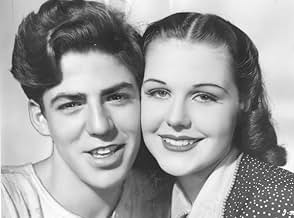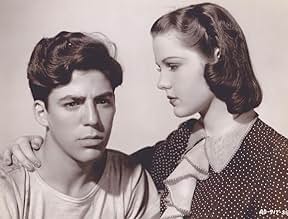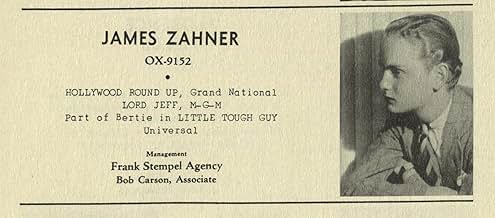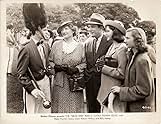Ajouter une intrigue dans votre langueAfter his father is sentenced to death for accidentally killing a cop, Johnny's family is left to fight for survival. His sister becomes a burlesque performer for money while Johnny joins a ... Tout lireAfter his father is sentenced to death for accidentally killing a cop, Johnny's family is left to fight for survival. His sister becomes a burlesque performer for money while Johnny joins a local gang and turns to a life of street crime.After his father is sentenced to death for accidentally killing a cop, Johnny's family is left to fight for survival. His sister becomes a burlesque performer for money while Johnny joins a local gang and turns to a life of street crime.
- Réalisation
- Scénario
- Casting principal
- Récompenses
- 2 victoires au total
Edward Pawley
- Jim Boylan
- (as Ed Pawley)
Hal E. Chester
- Dopey
- (as Hally Chester)
Victor Adams
- Secretary
- (non crédité)
Edward Arnold Jr.
- Fat
- (non crédité)
Hooper Atchley
- Mr. Randall
- (non crédité)
Avis à la une
This film gives great insight as to how life was for many "street" kids in NYC right after the depression and it is eerily similar to the plight of street kids in NYC today. The "dead end kids" is an awesome name. They are wanna be thugs; Violent, aggressive, uneducated, beligerent, witty and daring. One kid even wears a yankee baseball jersey with # 3 on the back just like the kids wear Derek Jeter jerseys today.)
Up until a few years ago, the lower east side was a similarly tough area, except it was inhabited by mostly people of color. Gentrification began in the 90s and has since transformed the lower east side into an affluent, yuppie filled, unaffordable place to live for the average citizen of any color in NYC.
While watching the movie, I listened to the street-slang and trouble-making behavior of the "dead end kids", and I couldn't help but saying to myself that this would be a so called "hood" film if it had been made today, like "Juice" starring Omar Epps and Tupac. Funny how the names and faces have changed, but the story is still the same.
Being from NYC myself, I felt suspended in time while watching it. My Mom was 2 and my father(may he rest in peace) was 11 in 1938.
Up until a few years ago, the lower east side was a similarly tough area, except it was inhabited by mostly people of color. Gentrification began in the 90s and has since transformed the lower east side into an affluent, yuppie filled, unaffordable place to live for the average citizen of any color in NYC.
While watching the movie, I listened to the street-slang and trouble-making behavior of the "dead end kids", and I couldn't help but saying to myself that this would be a so called "hood" film if it had been made today, like "Juice" starring Omar Epps and Tupac. Funny how the names and faces have changed, but the story is still the same.
Being from NYC myself, I felt suspended in time while watching it. My Mom was 2 and my father(may he rest in peace) was 11 in 1938.
Having been a fan of the Bowery Boys/East Side Kids, I eagerly grabbed this movie, expecting to see the wildly madcap misadventures of Mugs, Glimpy and the rest of the East Side Kids, boys whose misadventures stemmed from their being naughty, though not altogether bad, along with the local cops who tended to feel that the East Side Kids were a far bigger threat and who belonged behind bars. As a rule, the East Side Kids, in a race against time, with the law hot on their trails usually wound up making good and coming out the heroes in the end, by using their street smarts and their smart alack attitude. This was the general formula of the movies starring the East Side Kids. The East Side Kids were truly the kings of the B-grade movies.
With this in mind, I was at first disappointed in this movie. It was a grim and somewhat tragic story of a gang of boys stuck on the wrong side of the tracks and who, through circumstances beyond their control, wound up on the wrong side of the law, turning to crime.
Through it all, some of the character traits that would shine bright in their later movies, was apparent. There were some comic moments in this movie, though too few and far between in this movie.
In spite of my disappointment, this movie is one movie that I can watch over and over again.
A point of interest to the technical-minded viewer who loves to look for detail, the record changer in Cyril's house is a Capehart, one of the high end record changers at that time. And in the 1930s, this model cost more than the price of a new car!
With this in mind, I was at first disappointed in this movie. It was a grim and somewhat tragic story of a gang of boys stuck on the wrong side of the tracks and who, through circumstances beyond their control, wound up on the wrong side of the law, turning to crime.
Through it all, some of the character traits that would shine bright in their later movies, was apparent. There were some comic moments in this movie, though too few and far between in this movie.
In spite of my disappointment, this movie is one movie that I can watch over and over again.
A point of interest to the technical-minded viewer who loves to look for detail, the record changer in Cyril's house is a Capehart, one of the high end record changers at that time. And in the 1930s, this model cost more than the price of a new car!
LITTLE TOUGH GUY (Universal, 1938), directed by Harold Young, best known for his direction of the British adventure classic, THE SCARLET PIMPERNEL (1934), became the studio's answer and contribution to the Samuel Goldwyn social drama, DEAD END (1937). Though not as classic as DEAD END nor ANGELS WITH DIRTY FACES (Warner Brothers, 1938), thus missing tough guy leadership provided by either Humphrey Bogart or James Cagney, LITTLE TOUGH GUY contains some of the familiar plot elements along with gang members from the aforementioned dramas as Billy Halop, Huntz Hall, Gabriel Dell, and Bernard Punsley, yet missing Leo Gorcey and Bobby Jordan in the process. There's even an added attraction of Marjorie Main from DEAD END once again playing the long suffering mother, with little or no opportunity doing her forte in comedy.
Set in the tenements of New York City, the story revolves around the Boylan family: Kay (Helen Parrish), the eldest child of Jim and Mrs. Boylan (Edward Pawley and Marjorie Main), engaged to marry Paul Wilson (Robert Wilcox). She also has a younger teenage brother named Johnny (Billy Halop) who would rather be working than going to school. Johnny is admired by Rita Belle Warren (Peggy Stewart), but gives little attention to how he feels about her. As unemployed Jim Boylan attempts finding a new job at a factory where employees are striking for better wages, he's later accused and arrested for the murder of a policeman. For this, Johnny finds himself being ignored by his friends; Kay loses her job and breaks her engagement to Paul; leading to the Boylans become evicted from their apartment, having to move to another part of town. As Johnny earns money selling newspapers on street corners, he encounters gang leader "Pig" (Huntz Hall). Following a street fight in which Johnny wins, he soon develops a lasting friendship with Pig and his gang, String (Gabriel Dell), Sniper (David Gorcey) and Dopey (Hally Chester). After his father is found guilty and executed, Johnny and his new friends join forces in forming a crime wave on their own, even taking in Cyril Gerrard (Jackie Searl), a bored rich kid out for adventure, and getting deeper in trouble along the way. Featuring Helen MacKeller, Olin Howland, Charles Trowbridge and Robert Homans in smaller roles.
What makes LITTLE TOUGH GUY most interesting, especially for anyone familiar with the much latter and better known works of Leo Gorcey and Huntz Hall in the long-running "Bowery Boys" series for Monogram (1946-1958) is the presence of Huntz Hall. Better known for playing goofy characters from that series, he's believably good playing a tough gang leader. Though the first half of the plot development revolves around Billy Halop and other characters (Robert Wilcox and Helen Parrish), the second half builds up considerably involving the teenage crime wave.
Interestingly, Universal produced what developed into "The Little Tough Guys" series (1938-1943), but aside from the 85 minute LITTLE TOUGH GUY playing as part of a 45-minute featurette in public television's "Matinee at the Bijou" in the 1980s, and becoming available on both video cassette and DVD, the subsequent films that followed, with Halop playing different character roles in some, never became as famous as Monogram's most televised "East Side Kids" and "The Bowery Boys." LITTLE TOUGH GUY does not go without interest and should be considered for viewing at least once. (**1/2)
Set in the tenements of New York City, the story revolves around the Boylan family: Kay (Helen Parrish), the eldest child of Jim and Mrs. Boylan (Edward Pawley and Marjorie Main), engaged to marry Paul Wilson (Robert Wilcox). She also has a younger teenage brother named Johnny (Billy Halop) who would rather be working than going to school. Johnny is admired by Rita Belle Warren (Peggy Stewart), but gives little attention to how he feels about her. As unemployed Jim Boylan attempts finding a new job at a factory where employees are striking for better wages, he's later accused and arrested for the murder of a policeman. For this, Johnny finds himself being ignored by his friends; Kay loses her job and breaks her engagement to Paul; leading to the Boylans become evicted from their apartment, having to move to another part of town. As Johnny earns money selling newspapers on street corners, he encounters gang leader "Pig" (Huntz Hall). Following a street fight in which Johnny wins, he soon develops a lasting friendship with Pig and his gang, String (Gabriel Dell), Sniper (David Gorcey) and Dopey (Hally Chester). After his father is found guilty and executed, Johnny and his new friends join forces in forming a crime wave on their own, even taking in Cyril Gerrard (Jackie Searl), a bored rich kid out for adventure, and getting deeper in trouble along the way. Featuring Helen MacKeller, Olin Howland, Charles Trowbridge and Robert Homans in smaller roles.
What makes LITTLE TOUGH GUY most interesting, especially for anyone familiar with the much latter and better known works of Leo Gorcey and Huntz Hall in the long-running "Bowery Boys" series for Monogram (1946-1958) is the presence of Huntz Hall. Better known for playing goofy characters from that series, he's believably good playing a tough gang leader. Though the first half of the plot development revolves around Billy Halop and other characters (Robert Wilcox and Helen Parrish), the second half builds up considerably involving the teenage crime wave.
Interestingly, Universal produced what developed into "The Little Tough Guys" series (1938-1943), but aside from the 85 minute LITTLE TOUGH GUY playing as part of a 45-minute featurette in public television's "Matinee at the Bijou" in the 1980s, and becoming available on both video cassette and DVD, the subsequent films that followed, with Halop playing different character roles in some, never became as famous as Monogram's most televised "East Side Kids" and "The Bowery Boys." LITTLE TOUGH GUY does not go without interest and should be considered for viewing at least once. (**1/2)
The weakest and least known of all the film series spawned from the "Dead End" Kids were those made by Universal. These Universal films which were cranked out between 1938 and 1943, overlapped the concurrent "Dead End" Kids at Warner Bros (1938-1939), and The East Side Kids films (1940-1945) at Monogram. LITTLE TOUGH GUY was the first of Universals contribution to the series. This first entry is only passable. The first half is poorly directed and many elements are hard to take. The second half, when the kids go on a wild crime spree comes off better. Of interest to fans of the series is seeing Huntz Hall, in a departure from playing his usual dumbbell role, plays a real tough guy in this one. This was also David Gorceys first appearance in the series. His more famous brother Leo was not in this one (nor any of the subsequent Universal entries). Hally Chester also makes him debut as a gang member in this one (he previously had a bit part in CRIME SCHOOL.)
The first entry for the Dead End Kids & Little Tough Guys series for Universal from 1938. Made between "Crime School" & "Angels With Dirty Faces". This series also overlapped the popular East Side Kids series for Monogram. Their last entry for Universal was "Keep 'Em Slugging" in 1943 with Bobby Jordan replacing Billy Halop as the gang leader. "Little Tough Guy" stands out in seeing Huntz Hall as a real tough guy & gang leader instead of playing his usual dumbbell clown role. I just wish he would've done it more often because he was good at it & it also worked better with a more serious Huntz Hall matched against Billy Halop but in the subsequent entries he's back to being goofy again & it doesn't work as well with Halop as it does with Leo Gorcey. Although he was a bit serious & dramatic in the 3 serials.
I have the entire Universal Little Tough Guys DVD box set from "Little Tough Guys In Society" (1938) & "Call A Messenger" (1939) to "Mob Town" (1941). I've watched all these films & it's probably their rarest & least known series but it's still good & entertaining. Some of the films like "Give Us Wings" (1941) feature all the original Dead End Kids, all except Leo Gorcey. Too bad Leo Gorcey wasn't in any of these films because it might've worked better than it did & maybe the films would've been more memorable. In the original Dead End Kids I always enjoyed the confrontations between Leo Gorcey & Billy Halop. Too bad they couldn't work together anymore after Warner Bros dropped them.
I have the entire Universal Little Tough Guys DVD box set from "Little Tough Guys In Society" (1938) & "Call A Messenger" (1939) to "Mob Town" (1941). I've watched all these films & it's probably their rarest & least known series but it's still good & entertaining. Some of the films like "Give Us Wings" (1941) feature all the original Dead End Kids, all except Leo Gorcey. Too bad Leo Gorcey wasn't in any of these films because it might've worked better than it did & maybe the films would've been more memorable. In the original Dead End Kids I always enjoyed the confrontations between Leo Gorcey & Billy Halop. Too bad they couldn't work together anymore after Warner Bros dropped them.
Le saviez-vous
- ConnexionsFeatured in Film Breaks: The Dead End Kids (1999)
Meilleurs choix
Connectez-vous pour évaluer et suivre la liste de favoris afin de recevoir des recommandations personnalisées
Détails
- Date de sortie
- Pays d’origine
- Langue
- Aussi connu sous le nom de
- Graine d'Apache
- Lieux de tournage
- Société de production
- Voir plus de crédits d'entreprise sur IMDbPro
- Durée
- 1h 26min(86 min)
- Couleur
- Rapport de forme
- 1.37 : 1
Contribuer à cette page
Suggérer une modification ou ajouter du contenu manquant
































